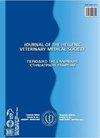Effects of ochratoxin on the performance, haematobiochemical profile, macroscopic and histopathological lesions in quails (Coturnix coturnix Japonica)
IF 0.4
4区 农林科学
Q4 VETERINARY SCIENCES
引用次数: 0
Abstract
Mycotoxins are ubiquitous in the environment and occur naturally in human food and animal feed. Therefore, in this study the performance, haematobiochemical profiles, macroscopic and histopathological lesions in quails caused by ochratoxin (OTA) were examined. The OTA was obtained by culturing the spore of Aspergillus ochraceus. Sixty healthy male quails were selected and distributed into 12 replicates (5 quails per replicate) in a completely randomized block arrangement. Each experimental diet was assigned to 4 replicate groups. Quails in first group were fed on standard basal diet (CP 27%) without the addition of OTA (OTA-0; negative control), while in other groups OTA was incorporated in basal diet at 1 mg/kg (OTA-1) and 2 mg/kg (OTA-2) of basal diet, respectively. The feeding trial continued for 21 days experimental period. Clinical signs observed in OTA-fed birds were diarrhea, broken feathers, increased water intake, and depression. In addition, lower (p < 0.05) feed intake was reported in OTA-fed quails. Likewise, weight gain was reduced (p < 0.05) in OTA-fed groups. Gross lesions of hypertrophy, hemorrhages, paleness and friability were detected in the liver and kidney of OTA-treated birds. Microscopic examination of kidney and liver showed degeneration and sloughing of tubular epithelium in the kidney, narrowing of the lumen of kidney tubules, and hepatic fatty infiltration and necrosis of liver parenchyma. The serum Alanine transaminase, Aspartate transaminase, urea, and creatinine levels of OTA-fed birds were higher (p < 0.05) than OTA-0. However, serum total protein and albumin were lower (p < 0.05) in OTA-treated groups in a dose- dependent manner. Likely, red blood cell count, packed cell volume, and hemoglobin concentration were lower (p < 0.05) in OTA-treated groups. The results of this study indicate that OTA at ≥ 1 mg/kg feed is nephrotoxic and hepatotoxic, and cause hematobiochemical disorder in quails, which adversely affect their growth performance and may eventually lead to economic losses.赭曲霉毒素对鹌鹑生产性能、血液生化特征、宏观及组织病理学病变的影响
真菌毒素在环境中无处不在,自然存在于人类食物和动物饲料中。因此,本研究对鹌鹑受赭曲霉毒素(OTA)感染后的生产性能、血液生化特征、宏观及组织病理学病变进行了研究。OTA是通过培养赭曲霉孢子获得的。选取健康雄性鹌鹑60只,按完全随机区组法分成12个重复(每个重复5只)。每种试验饲粮分为4个重复组。第一组鹌鹑饲喂标准基础饲粮(CP 27%),不添加OTA (OTA-0;阴性对照),其余各组分别在基础饲粮中添加1 mg/kg (OTA-1)和2 mg/kg (OTA-2)的OTA。试验期21 d。经ota喂养的鸟类临床表现为腹泻、羽毛断裂、饮水量增加和情绪低落。此外,较低的(p <0.05)的采食量。同样,体重增加也减少了(p <0.05)。经ota处理的禽鸟肝脏和肾脏出现肥大、出血、苍白和易碎等肉眼病变。肾、肝镜示肾小管上皮变性脱落,肾小管管腔变窄,肝脂肪浸润,肝实质坏死。食用鸟血清丙氨酸转氨酶、天冬氨酸转氨酶、尿素和肌酐水平较高(p <0.05)高于OTA-0。血清总蛋白和白蛋白较低(p <0.05),并呈剂量依赖性。可能是红细胞计数、堆积细胞体积和血红蛋白浓度较低(p <0.05)。本研究结果表明,饲料中≥1 mg/kg的OTA具有肾毒性和肝毒性,会引起鹌鹑血液生化紊乱,影响鹌鹑的生长性能,最终可能导致经济损失。
本文章由计算机程序翻译,如有差异,请以英文原文为准。
求助全文
约1分钟内获得全文
求助全文
来源期刊

Journal of the Hellenic Veterinary Medical Society
VETERINARY SCIENCES-
CiteScore
0.60
自引率
0.00%
发文量
83
审稿时长
>12 weeks
期刊介绍:
The Journal of the Hellenic Veterinary Medical Society (J Hellenic Vet Med Soc) is a quarterly peer-reviewed journal that publishes articles in all aspects of veterinary science and related disciplines. It is published by the Hellenic Veterinary Medical Society and is indexed in the Web of Science and in Scopus.
There are no publication fees in the journal. Authors considering submitting manuscripts for evaluation and publication are requested to read carefully the instructions for authors and fully comply with them.
Non-complying manuscripts may be returned to the corresponding author for formatting.
 求助内容:
求助内容: 应助结果提醒方式:
应助结果提醒方式:


